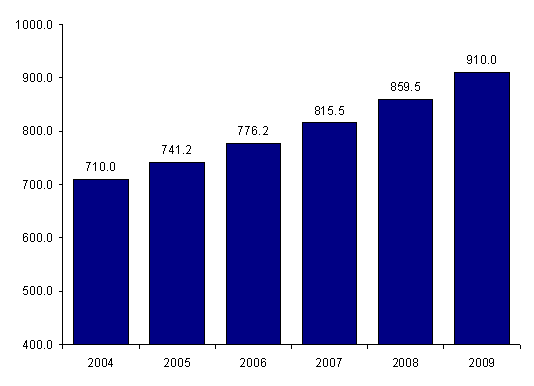
Flow
Research, Inc.
27 Water Street
Wakefield, MA
01880
(781) 245-3200
(781) 224-7552 (fax)
Contact:
Belinda Burum, Flow Research: (781) 245-3200 – belinda@flowresearch.com
For immediate release
New Flow Research Study Finds Fast-Growing Magnetic Flowmeter Market
Wakefield, Massachusetts; September 14, 2005 — The
worldwide magnetic flowmeter market equaled $710 million in 2004,
according to a new market study from Flow Research (www.flowresearch.com).
The study is called The Global Market for Magnetic Flowmeters, 3rd Edition.
Revenues from the sale of magnetic flowmeters are projected to
increase at a compound annual growth rate (CAGR) of 5.1 percent through
2009, when they are expected to equal $910 million.
Europe accounts for 41 percent of the total, while North America
accounts for just over 21 percent. The
fastest growth will occur in the Asia without Japan and the Rest of World
regions.
In many applications, magnetic flowmeters are
displacing traditional technology meters, including differential pressure
(DP), positive displacement, and turbine meters.
Unlike positive displacement and turbine meters, magnetic
flowmeters do not have moving parts that are subject to wear over time.
And unlike DP flowmeters, magnetic flowmeters do not use a primary
element to cause a constriction in the flowstream.
The use of a primary element can cause significant pressure loss,
and primary elements are themselves subject to wear.
With no moving parts and little pressure loss, magnetic flowmeters
offer reliability and low cost of ownership.
Dr. Jesse Yoder, president of Flow Research, explains
the growth in the magnetic flowmeter market as follows: “Customers are selecting magnetic flowmeters due to their
accuracy and reliability. They
are also taking advantage of a number of technological improvements to
magnetic flowmeters made in the past few years.
These include improvements in high-strength DC meters, accuracy
enhancements, the increased availability of 2-wire meters, and the
introduction of more types of magnetic flowmeter liners.
In addition, more companies are now offering insertion meters,
which enable magnetic flowmeters to measure flow in large pipes.
They are a highly trusted flowmeter for liquid applications.”
With all of their advantages, the primary limitation
of magnetic flowmeters is their inability to measure the flow of
nonconductive fluids. Suppliers
have made progress in this area, bringing out magnetic flowmeters that can
operate successfully in liquids with very low conductivity values.
But despite this, magnetic flowmeters cannot measure the flow of
gas or steam. Even so,
magnetic flowmeters remain the meter of choice for a broad range of liquid
applications.
Flow Research, Inc.
Flow Research (www.flowresearch.com) is a market research company that specializes in providing market data and strategies on flow, pressure, and temperature products. In addition to the 500-page study, The Global Market for Magnetic Flowmeters, 3rd Edition (http://www.flowresearch.com/Magnetic_2005/overview.htm), current study topics include vortex flowmeters, DP flowmeters and primary elements, and valves. Flow Research also publishes a quarterly update on the oil & gas, refining, and power & renewables industries called the Worldflow Energy Monitor.
Total Shipments of Magnetic Flowmeters Worldwide
(Millions
of Dollars)

Compound
Annual Growth Rate (CAGR) = 5.1%